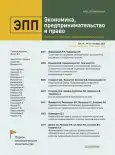A multi-factory model of the determinants and forecasting of forest product prices (on the example of pulp)
- Authors: Sushko O.P.1,2
-
Affiliations:
- Plekhanov Russian University of Economics
- Moscow State Technical University of Civil Aviation
- Issue: Vol 13, No 10 (2023)
- Pages: 4117-4134
- Section: Articles
- URL: https://journals.eco-vector.com/2222-534X/article/view/625218
- DOI: https://doi.org/10.18334/epp.13.10.118934
- ID: 625218
Cite item
Abstract
The high volatility of prices for most types of forest products is the problem of sustainability of the forest complex not only for Russia, but also for the world market. Fluctuations in global and domestic prices for forest products create problems for planning and forecasting the activities of all subjects of the forest complex. Researchers have developed a variety of forecasting methods and models from simple averaging techniques to complex software and hardware systems, but the changes taking place today predetermine the development of new forecasting methods. Predictive models based on a combination of quantitative and qualitative methods are becoming more and more popular. The author has examined many factors that determine the price movement of timber products and influence various components of price dynamics. The main factors have been identified. The structure of price dynamics is determined; and a trend-cyclical model is developed. According to the developed adaptive model of price forecasting, two variants of price dynamics for the period up to 2029 with a trend according to the actually established trend of the previous period are designed. The second variant of forecasting price dynamics is presented with an adjusted trend based on China's GDP growth rates according to the official forecast. The results of the study of trends and patterns of price movements and the development of multivariate price forecasting will broaden the theoretical and practical foundations of macro and micro forecasting.
About the authors
Olga Petrovna Sushko
Plekhanov Russian University of Economics; Moscow State Technical University of Civil Aviation
Email: osushko@mail.ru
References
- Buongiorno J. On the accuracy of international forest product statistics // Forestry. – 2018. – № 5. – p. 541-551. – doi: 10.1093/forestry/cpy025.
- Gordeev R. Comparative advantages of Russian forest products on the global market // Forest Policy and Economics. – 2020. – p. 102286. – doi: 10.1016/j.forpol.2020.102286.
- Friedman Milton The Permanent Income Hypothesis. Nber.org. [Электронный ресурс]. URL: https://www.nber.org/system/files/chapters/c4405/c4405.pdf.
- Kailash Ch.P. Price movements in futures and spot markets: evidence from the sp cnx nifty index // Review of Business and Economics Studies. – 2017. – № 1. – p. 32-41.
- Kallio A.M.I., Solberg, B. On the Reliability of International Forest Sector Statistics: Problems and Needs for Improvements // Forests. – 2018. – № 7. – p. 407. – doi: 10.3390/f9070407.
- Solodky M.O. Futures market – important factor of price stabilization // Экономика АПК. – 2013. – № 12(230). – p. 044-048.
- Sushko O.P., Plastinin A.V. Analysis and forecast of prices on pulp and paper production of Russian enterprises and world goods market // Studies on Russian Economic Development. – 2015. – № 4. – p. 347-350. – doi: 10.1134/S1075700715040115.
- Olsson M.O. Systemic Interventions to Promote Institutional Change in the Russian Forest Sector // Review of Policy Research. – 2006. – № 2. – p. 505-530. – doi: 10.1111/j.1541-1338.2006.00213.x.
- Ross S.A. The arbitrage theory of capital asset pricing // Journal of Economic Theory. – 1976. – p. 341-360. – doi: 10.1016/0022-0531(76)90046-6.
- Дж. Р. Хикс, Р.Г.Д. Аллен Пересмотр теории ценности. / В книге: Вехи экономической мысли. Том 1. Теория потребления и спроса. - СПб.: Экономическая школа, 2000. – 380 c.
- Аль Каркхи М.М.С. Модели информационного поиска в многофакторных потоках // Информационные процессы. – 2022. – № 1(22). – c. 25-28. – doi: 10.52529/27821617_2022_3_1_25.
- Антонова Н.Е., Ломакина Н.В. Природопользование на Дальнем Востоке России: системный взгляд на современные проблемы // Пространственная экономика. – 2023. – № 1. – c. 187-191. – doi: 10.14530/se.2023.1.187-191.
- Антонова Н.Е., Шейнгауз А.С. Управление лесным комплексом многолесного региона. - Владивосток: Дальнаука, 2002. – 192 c.
- Блюмин И.Г. Теории экономической динамики. / Критика буржуазной политической экономии: В 3 томах. - М.: Изд-во АН СССР, 1962.
- Воронков П.Т., Борисова Л.В., Белов А.Н. Исследование особенностей динамики средних региональных цен лесоматериалов круглых в федеральных округах российской федерации // Лесохозяйственная информация. – 2014. – № 1. – c. 3-10.
- Кендалл М.Дж., Стьюарт А. Многомерный статистический анализ и временные ряды. / Пер. с англ. - М.: Наука, 1976. – 736 c.
- Рима И.Х. Неоклассическая теория и раскол: 1890—1930 гг. / В книге: Современная экономическая мысль. Пер. с англ. - М.: Прогресс, 1981. – 51-67 c.
- Рябова Т.Г., Мохирев А.П., Медведев С.О., Лышко А.С. Динамика и факторы стоимости лесоматериалов в лесной промышленности России // Фундаментальные исследования. – 2020. – № 4. – c. 94-98. – doi: 10.17513/fr.42730.
- Сушко О.П., Пластинин А.В. Ценовая динамика рынка как фактор комплексного производства лесопромышленной продукции // Глобальные вызовы в экономике и развитие промышленности (INDUSTRY-2016): Труды научно-практической конференции с зарубежным участием. Санкт-Петербург, 2016. – c. 521-526.
- Сушко О.П., Пластинин А.В. Прогнозирование ценовой динамики целлюлозно-бумажной продукции российских и мировых производителей. - Архангельск: Северный (Арктический) федеральный университет им. М.В. Ломоносова, 2015. – 136 c.
- Шаллыев Ч., Маткаримов А. Развитие теории многофакторной модели при моделировании макроэкономических процессов // Интернаука. – 2022. – № 13-5(236). – c. 20-22.
- Шейнгауз А.С. Новый феномен восточноазиатской экономики - китайский лесной комплекс (обзор состояния и перспектив) // Пространственная экономика. – 2006. – № 4. – c. 59-80.
- Шейнгауз А.С. Исследования по лесной экономике на российском Дальнем Востоке // Вестник Дальневосточного отделения Российской академии наук. – 2007. – № 5(135). – c. 3-12.
Supplementary files








